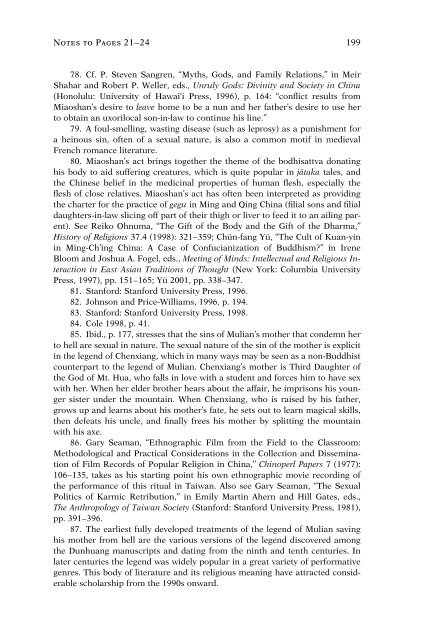Two Precious Scroll Narratives of Guanyin and Her ... - Khamkoo
Two Precious Scroll Narratives of Guanyin and Her ... - Khamkoo
Two Precious Scroll Narratives of Guanyin and Her ... - Khamkoo
You also want an ePaper? Increase the reach of your titles
YUMPU automatically turns print PDFs into web optimized ePapers that Google loves.
Notes to Pages 21–24 199<br />
78. Cf. P. Steven Sangren, ‘‘Myths, Gods, <strong>and</strong> Family Relations,’’ in Meir<br />
Shahar <strong>and</strong> Robert P. Weller, eds., Unruly Gods: Divinity <strong>and</strong> Society in China<br />
(Honolulu: University <strong>of</strong> Hawai‘i Press, 1996), p. 164: ‘‘conflict results from<br />
Miaoshan’s desire to leave home to be a nun <strong>and</strong> her father’s desire to use her<br />
to obtain an uxorilocal son-in-law to continue his line.’’<br />
79. A foul-smelling, wasting disease (such as leprosy) as a punishment for<br />
a heinous sin, <strong>of</strong>ten <strong>of</strong> a sexual nature, is also a common motif in medieval<br />
French romance literature.<br />
80. Miaoshan’s act brings together the theme <strong>of</strong> the bodhisattva donating<br />
his body to aid suffering creatures, which is quite popular in jātaka tales, <strong>and</strong><br />
the Chinese belief in the medicinal properties <strong>of</strong> human flesh, especially the<br />
flesh <strong>of</strong> close relatives. Miaoshan’s act has <strong>of</strong>ten been interpreted as providing<br />
the charter for the practice <strong>of</strong> gegu in Ming <strong>and</strong> Qing China (filial sons <strong>and</strong> filial<br />
daughters-in-law slicing <strong>of</strong>f part <strong>of</strong> their thigh or liver to feed it to an ailing parent).<br />
See Reiko Ohnuma, ‘‘The Gift <strong>of</strong> the Body <strong>and</strong> the Gift <strong>of</strong> the Dharma,’’<br />
History <strong>of</strong> Religions 37.4 (1998): 321–359; Chün-fang Yü, ‘‘The Cult <strong>of</strong> Kuan-yin<br />
in Ming-Ch’ing China: A Case <strong>of</strong> Confucianization <strong>of</strong> Buddhism?’’ in Irene<br />
Bloom <strong>and</strong> Joshua A. Fogel, eds., Meeting <strong>of</strong> Minds: Intellectual <strong>and</strong> Religious Interaction<br />
in East Asian Traditions <strong>of</strong> Thought (New York: Columbia University<br />
Press, 1997), pp. 151–165; Yü 2001, pp. 338–347.<br />
81. Stanford: Stanford University Press, 1996.<br />
82. Johnson <strong>and</strong> Price-Williams, 1996, p. 194.<br />
83. Stanford: Stanford University Press, 1998.<br />
84. Cole 1998, p. 41.<br />
85. Ibid., p. 177, stresses that the sins <strong>of</strong> Mulian’s mother that condemn her<br />
to hell are sexual in nature. The sexual nature <strong>of</strong> the sin <strong>of</strong> the mother is explicit<br />
in the legend <strong>of</strong> Chenxiang, which in many ways may be seen as a non-Buddhist<br />
counterpart to the legend <strong>of</strong> Mulian. Chenxiang’s mother is Third Daughter <strong>of</strong><br />
the God <strong>of</strong> Mt. Hua, who falls in love with a student <strong>and</strong> forces him to have sex<br />
with her. When her elder brother hears about the affair, he imprisons his younger<br />
sister under the mountain. When Chenxiang, who is raised by his father,<br />
grows up <strong>and</strong> learns about his mother’s fate, he sets out to learn magical skills,<br />
then defeats his uncle, <strong>and</strong> finally frees his mother by splitting the mountain<br />
with his axe.<br />
86. Gary Seaman, ‘‘Ethnographic Film from the Field to the Classroom:<br />
Methodological <strong>and</strong> Practical Considerations in the Collection <strong>and</strong> Dissemination<br />
<strong>of</strong> Film Records <strong>of</strong> Popular Religion in China,’’ Chinoperl Papers 7 (1977):<br />
106–135, takes as his starting point his own ethnographic movie recording <strong>of</strong><br />
the performance <strong>of</strong> this ritual in Taiwan. Also see Gary Seaman, ‘‘The Sexual<br />
Politics <strong>of</strong> Karmic Retribution,’’ in Emily Martin Ahern <strong>and</strong> Hill Gates, eds.,<br />
The Anthropology <strong>of</strong> Taiwan Society (Stanford: Stanford University Press, 1981),<br />
pp. 391–396.<br />
87. The earliest fully developed treatments <strong>of</strong> the legend <strong>of</strong> Mulian saving<br />
his mother from hell are the various versions <strong>of</strong> the legend discovered among<br />
the Dunhuang manuscripts <strong>and</strong> dating from the ninth <strong>and</strong> tenth centuries. In<br />
later centuries the legend was widely popular in a great variety <strong>of</strong> performative<br />
genres. This body <strong>of</strong> literature <strong>and</strong> its religious meaning have attracted considerable<br />
scholarship from the 1990s onward.

















